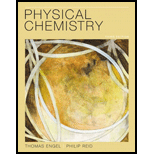
Physical Chemistry Plus Mastering Chemistry With Etext -- Access Card Package (3rd Edition) (engel Physical Chemistry Series)
3rd Edition
ISBN: 9780321766205
Author: Thomas Engel, Philip Reid
Publisher: PEARSON
expand_more
expand_more
format_list_bulleted
Question
Chapter 6, Problem 6.19CP
Interpretation Introduction
Interpretation: The maximum expansion work available to carry out the combustion reactions in example 6.1 and 6.2 needs to be determined. The magnitude and sign of the work needs to be determined.
Concept Introduction: The total work doe is calculated as follows:
Here,
Expert Solution & Answer
Want to see the full answer?
Check out a sample textbook solution
Students have asked these similar questions
Please help me solve this reaction.
Indicate the products obtained by mixing 2,2-dimethylpropanal with acetaldehyde and sodium ethoxide in ethanol.
Synthesize 2-Ethyl-3-methyloxirane from dimethyl(propyl)sulfonium iodide using the necessary organic or inorganic reagents. Draw the structures of the compounds.
Chapter 6 Solutions
Physical Chemistry Plus Mastering Chemistry With Etext -- Access Card Package (3rd Edition) (engel Physical Chemistry Series)
Ch. 6 - Prob. 6.1CPCh. 6 - Prob. 6.2CPCh. 6 - Prob. 6.3CPCh. 6 - Prob. 6.4CPCh. 6 - Prob. 6.5CPCh. 6 - Prob. 6.6CPCh. 6 - Prob. 6.7CPCh. 6 - Prob. 6.8CPCh. 6 - Prob. 6.9CPCh. 6 - Prob. 6.10CP
Ch. 6 - Prob. 6.11CPCh. 6 - Prob. 6.12CPCh. 6 - Prob. 6.13CPCh. 6 - Prob. 6.14CPCh. 6 - Prob. 6.15CPCh. 6 - Prob. 6.16CPCh. 6 - Prob. 6.17CPCh. 6 - Prob. 6.18CPCh. 6 - Prob. 6.19CPCh. 6 - Prob. 6.20CPCh. 6 - Prob. 6.21CPCh. 6 - Prob. 6.22CPCh. 6 - Prob. 6.23CPCh. 6 - Prob. 6.24CPCh. 6 - Prob. 6.25CPCh. 6 - Prob. 6.26CPCh. 6 - Prob. 6.27CPCh. 6 - Prob. 6.28CPCh. 6 - Prob. 6.29CPCh. 6 - Prob. 6.30CPCh. 6 - Prob. 6.31CPCh. 6 - Prob. 6.1NPCh. 6 - Prob. 6.2NPCh. 6 - Prob. 6.3NPCh. 6 - Prob. 6.4NPCh. 6 - Prob. 6.5NPCh. 6 - Prob. 6.6NPCh. 6 - Prob. 6.7NPCh. 6 - Prob. 6.8NPCh. 6 - Prob. 6.9NPCh. 6 - Prob. 6.10NPCh. 6 - Prob. 6.11NPCh. 6 - Prob. 6.12NPCh. 6 - Prob. 6.13NPCh. 6 - Prob. 6.14NPCh. 6 - Prob. 6.15NPCh. 6 - Prob. 6.16NPCh. 6 - Prob. 6.17NPCh. 6 - Prob. 6.18NPCh. 6 - Prob. 6.19NPCh. 6 - Prob. 6.20NPCh. 6 - Prob. 6.21NPCh. 6 - Prob. 6.22NPCh. 6 - Prob. 6.23NPCh. 6 - Prob. 6.24NPCh. 6 - Prob. 6.25NPCh. 6 - Prob. 6.26NPCh. 6 - Prob. 6.27NPCh. 6 - Prob. 6.28NPCh. 6 - Prob. 6.29NPCh. 6 - Prob. 6.30NPCh. 6 - Prob. 6.31NPCh. 6 - Prob. 6.32NPCh. 6 - Prob. 6.33NPCh. 6 - Prob. 6.34NPCh. 6 - Prob. 6.35NPCh. 6 - Prob. 6.36NPCh. 6 - Prob. 6.37NPCh. 6 - Prob. 6.38NPCh. 6 - Prob. 6.39NPCh. 6 - Prob. 6.40NPCh. 6 - Prob. 6.41NPCh. 6 - Prob. 6.42NPCh. 6 - Prob. 6.43NP
Knowledge Booster
Similar questions
- Synthesize 2-Hydroxy-2-phenylacetonitrile from phenylmethanol using the necessary organic or inorganic reagents. Draw the structures of the compounds.arrow_forwardSynthesize N-Methylcyclohexylamine from cyclohexanol using the necessary organic or inorganic reagents. Draw the structures of the compounds.arrow_forwardSynthesize N-Methylcyclohexylamine from cyclohexanol using the necessary organic or inorganic reagents. Draw the structures of the compounds.arrow_forward
- If possible, please provide the formula of the compound 3,3-dimethylbut-2-enal.arrow_forwardSynthesize 1,4-dibromobenzene from acetanilide (N-phenylacetamide) using the necessary organic or inorganic reagents. Draw the structures of the compounds.arrow_forwardIndicate the products obtained by mixing (3-oxo-3-phenylpropyl)triphenylphosphonium bromide with sodium hydride.arrow_forward
- We mix N-ethyl-2-hexanamine with excess methyl iodide and followed by heating with aqueous Ag2O. Indicate the major products obtained.arrow_forwardIndicate the products obtained by mixing acetophenone with iodine and NaOH.arrow_forwardIndicate the products obtained by mixing 2-Propanone and ethyllithium and performing a subsequent acid hydrolysis.arrow_forward
- Indicate the products obtained if (E)-2-butenal and 3-oxo-butanenitrile are mixed with sodium ethoxide in ethanol.arrow_forwardQuestion 3 (4 points), Draw a full arrow-pushing mechanism for the following reaction Please draw all structures clearly. Note that this intramolecular cyclization is analogous to the mechanism for halohydrin formation. COH Br + HBr Brarrow_forwardIndicate the products obtained if 2,2-dimethylpropanal and acetaldehyde are mixed with sodium ethoxide in ethanol.arrow_forward
arrow_back_ios
SEE MORE QUESTIONS
arrow_forward_ios
Recommended textbooks for you
 ChemistryChemistryISBN:9781305957404Author:Steven S. Zumdahl, Susan A. Zumdahl, Donald J. DeCostePublisher:Cengage Learning
ChemistryChemistryISBN:9781305957404Author:Steven S. Zumdahl, Susan A. Zumdahl, Donald J. DeCostePublisher:Cengage Learning ChemistryChemistryISBN:9781259911156Author:Raymond Chang Dr., Jason Overby ProfessorPublisher:McGraw-Hill Education
ChemistryChemistryISBN:9781259911156Author:Raymond Chang Dr., Jason Overby ProfessorPublisher:McGraw-Hill Education Principles of Instrumental AnalysisChemistryISBN:9781305577213Author:Douglas A. Skoog, F. James Holler, Stanley R. CrouchPublisher:Cengage Learning
Principles of Instrumental AnalysisChemistryISBN:9781305577213Author:Douglas A. Skoog, F. James Holler, Stanley R. CrouchPublisher:Cengage Learning Organic ChemistryChemistryISBN:9780078021558Author:Janice Gorzynski Smith Dr.Publisher:McGraw-Hill Education
Organic ChemistryChemistryISBN:9780078021558Author:Janice Gorzynski Smith Dr.Publisher:McGraw-Hill Education Chemistry: Principles and ReactionsChemistryISBN:9781305079373Author:William L. Masterton, Cecile N. HurleyPublisher:Cengage Learning
Chemistry: Principles and ReactionsChemistryISBN:9781305079373Author:William L. Masterton, Cecile N. HurleyPublisher:Cengage Learning Elementary Principles of Chemical Processes, Bind...ChemistryISBN:9781118431221Author:Richard M. Felder, Ronald W. Rousseau, Lisa G. BullardPublisher:WILEY
Elementary Principles of Chemical Processes, Bind...ChemistryISBN:9781118431221Author:Richard M. Felder, Ronald W. Rousseau, Lisa G. BullardPublisher:WILEY

Chemistry
Chemistry
ISBN:9781305957404
Author:Steven S. Zumdahl, Susan A. Zumdahl, Donald J. DeCoste
Publisher:Cengage Learning

Chemistry
Chemistry
ISBN:9781259911156
Author:Raymond Chang Dr., Jason Overby Professor
Publisher:McGraw-Hill Education

Principles of Instrumental Analysis
Chemistry
ISBN:9781305577213
Author:Douglas A. Skoog, F. James Holler, Stanley R. Crouch
Publisher:Cengage Learning

Organic Chemistry
Chemistry
ISBN:9780078021558
Author:Janice Gorzynski Smith Dr.
Publisher:McGraw-Hill Education

Chemistry: Principles and Reactions
Chemistry
ISBN:9781305079373
Author:William L. Masterton, Cecile N. Hurley
Publisher:Cengage Learning

Elementary Principles of Chemical Processes, Bind...
Chemistry
ISBN:9781118431221
Author:Richard M. Felder, Ronald W. Rousseau, Lisa G. Bullard
Publisher:WILEY